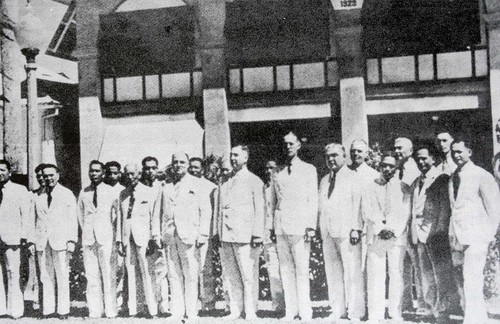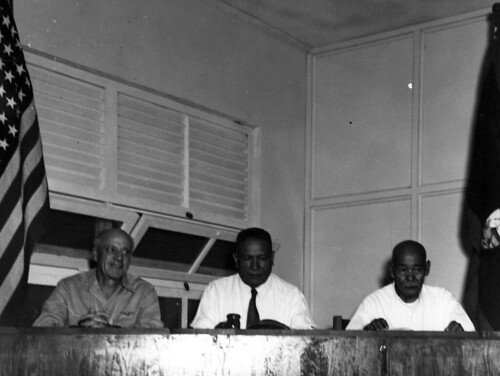First reorganization attempts
Many of the first US Naval governors of Guam attempted to reorganize the court system.
Guam’s first appointed US Navy Governor Richard P. Leary (1899–1900) created the Supreme Court of Guam in April 1900. With this act, the power of appeal was transferred from Spain’s Supreme Court in Madrid to the American governor. Leary appointed himself presiding justice, as had many Spanish governors in the past. Consisting of a five-man ruling panel, the Supreme Court of Guam served as the highest court in the island’s judicial system, functioning as an appellate court that oversaw all criminal cases.
Between 1903 and 1904, Naval Governor William E. Sewell added to the reformation of the island’s judicial system by amending tax, prison, and game laws. He also enacted orders to control commercial corporations as well as beginning the revision of the island’s criminal code. One of his main contributions to the island’s fledgling American judicial system was the issuance of General Order No. 69 in 1903 formalizing the system and procedures. This system remained relatively intact until the 1930s.
Naval Governor George Dyer (1904–1905) continued with the judicial modifications in 1905 when he replaced the Supreme Court of Guam with the Court of Appeals – an effort Dyer hoped would bring more organization to the island’s government. The new court consisted of three judges although the number would temporarily increase when capital cases were reviewed. Of the judges, at least two were CHamoru. However, what remained unaddressed was Guam’s ability to hold a trial by jury or to convict a person.
In 1910, Governor Edward Dorn (1907–1910) recognized the inability of the Spanish Court of First Instance to manage all cases, which prompted him to create Island Court. Because the judge of the Spanish Court of First Instance held all investigatory responsibility, Dorn alleviated those duties and passed them to the Island Attorney, forefather of today’s Attorney General of Guam. The island attorney then was Tomas Calvo. The Island Court consisted of two judges at the time: Luis de Torres and Joaquin Perez.
In the following years, other small courts were created, including the Police Court in 1906, followed by the Court of Equity, the Higher Court of Equity, and the Special Courts in 1916. Each court managed a respective area of dispute ranging from misdemeanors to felonies. A new courthouse was opened in 1929.
By 1933, the following courts had been successfully established: a Police Court, a Justice Court and the Island Court. There was also a Court of Appeals, which served as Guam’s Supreme Court which was comprised of five judges including the presiding justice, two Naval officers and two local judges.
The Police Court heard only misdemeanor criminal cases in which the penalty did not exceed six months or more of imprisonment or a fine of $100. Most of the cases handled by the Police Court included violations of traffic rules, public drunkenness, or sanitary regulations.
The Justice Court, precursor of the small claims court, maintained jurisdiction in criminal cases that involved a fine of more $100, but less than $300, or an imprisonment term of six months, but less than a year. The types of cases usually involved property disputes of less than $75, forcible entry, and debt collection of fines no more than $12.
The Island Court held general jurisdiction of both criminal and civil cases, excluding those assigned by law to another court; all probate matters; domestic and criminal cases; and, appeals from the Police Court which involved mandatory imprisonment or fines $25 or more. In 1949, the Island Court was comprised of one CHamoru judge.
Post World War II military courts
After the Japanese occupation during World War II in 1944, American forces declared a state of emergency martial law and military courts were established for the trial of civilians. The Summary Provost Court, comprised of one Naval officer, was established with jurisdiction similar to that of the pre-war justice court.
The Superior Provost Court, which also consisted of one Naval officer, handled all other less serious crimes, including those with unlimited fines and imprisonment of less than 10 years. The Military Commission tried all other serious crimes and remained the highest court at the time.
These courts had no jury and there was no option to appeal the decisions to a higher court, although the approval of the Secretary of the Navy was mandatory before execution of criminal cases.
Superior Court established
In April 1945, the Land and Claims Commission was formed by Naval authorities. Its purpose was to review and process war claims by the CHamorus, damage to property, personal injury, and death claims. However, since there were few local attorneys in Guam at that time, the CHamoru people often felt intimidated by the power and experience of American lawyers and felt that they were no match against them.
The Superior Court of Guam was established on 1 November 1947. A year later, the US Congress attempted to pass a bill to abolish it. The local people were unsatisfied with the handling of the court with regard to land condemnation cases and with the dual function of the Superior Court Judge John Fisher who also served as Presiding Justice of the Court of Appeals. However, in January of 1949, the bill was vetoed.
A new courthouse in Hagåtña opened in 1947 replacing the old courthouse in the Robert Coontz building. Over the next few years, the stipulations of Guam’s Organic Act were drawn up, much to the consternation of the US Department of Defense which wanted Guam to remain under control of the US Navy. By 1950, with the passage of the act, CHamorus were granted US citizenship. Guam became an unincorporated US territory and was granted the ability to form a judicial branch of the government of Guam—the first such rights afforded to the people of Guam.
As part of the 1950 Judiciary Act, a bill was drafted to strengthen the island’s court system. Judge Albert B. Maris—then chairman of the US Judicial Conference, judge of the 3rd Circuit Court of Appeals, and chief judge of the Emergency Court of Appeals—aided in the preparation of the judiciary bill; Public Law No. 17.
The Judiciary Act abolished the Justice Court, the Traffic Branch of the Police Court, and the Court of Appeals. The District Court of Guam, formed in 1950, assumed the responsibilities of the latter. The act further reduced the number of courts, including the Island Court, the Police Court, and the Commissioners Court to the District Court, which claimed jurisdiction for both federal and local cases.
For further reading
James, Roy E. “The Island Possession of Guam.” In America’s Pacific Dependencies. By Rupert Emerson. New York: American Institute of Pacific Relations, 1949.
Judiciary of Guam. “Judiciary of Guam (Hustisian Guahån).”
Rogers, Robert. Destiny’s Landfall: A History of Guam. Honolulu: University of Hawai’i Press, 1995.
Sanchez, Anthony P. Justice on Guam: A Historical Review. Hagåtña: Superior Court of Guam, 1991.
Sanchez, Pedro C. Guahan Guam: The History of Our Island. Hagåtña: Sanchez Publishing House, 1987.
US Naval Administration of Guam. Guam News Letter 3, no. 2 (August 1911).
–––. Guam News Letter 5, no. 4 (October 1913).




